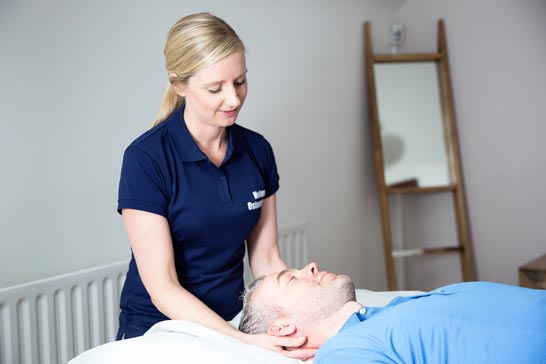The Best Exercises For Relieving Shoulder Pain and Frozen Shoulder
September 1, 2018
Maria Nolan

Many people suffer with shoulder pain in the UK, which can be caused by poor posture at work, trauma, sports or just sleeping awkwardly. Some of the most common diagnosis for shoulder pain include;
- rotator cuff dysfunction
- frozen shoulder
- biceps tendonitis
- acromioclavicular (A/C) joint dysfunction
- osteoarthritis
- hypermobility/instability of the shoulder
While it is difficult to know what may be causing your shoulder pain without an osteopath seeing you and assessing exactly what is going on, stretching exercises will invariably form a big part of your recovery. Before I give you my top exercises for shoulder pain, here are some simple lifestyle tips that we give our patients.
Daytime
The most important thing is to try and keep your shoulder joint mobile with regular, gentle stretching exercises.
It is better if you warm up your shoulder before performing your exercises. The best way to do this is to take a warm shower or bath beforehand.
Sleeping
It may sound obvious, but try to avoid sleeping on the side with the painful shoulder. Sleep on your back with a small pillow underneath the bad shoulder to support it. Alternatively, sleep on your other side and hug a pillow.
Adopting a foetal position and placing a pillow between your knees can also help ease pain for many patients.
Ensure that your neck is adequately supported to take the pressure off the shoulder. If the neck is not supported, the nerves that run from the neck to the arm can get compressed, and this can result in numbness or tingling, usually with the compression of a nerve from the sleeping position.
My Top Exercises for Shoulder Pain
NOTE: With all of these stretches, it should be a stretch and not pain. If it is painful, ease off the stretch a little.
- swing

- With your shoulder relaxed, place the hand of your good arm on a table or chair and lean forward slightly
- Allow the affected arm to hang down and swing the arm clockwise in small circles 10 times. The circles should be about a foot in diameter
- Repeat the exercise, swinging the arm in an anti-clockwise direction 10 times
- Its best if you do this exercise first as it is very useful for loosening up the affected shoulder. Do it once a day
2. Towel stretch

- With both arms straight, hold one end of a towel behind your back and grab the opposite end with your other hand
- Using your good arm, gently pull the affected arm slowly upward to stretch it
- Hold for 3 breaths and release back to the starting position
- Repeat this exercise 10 times, once a day
3. Finger walk

- Face a wall and extend the affected arm fully so that only your finger tips are touching the wall
- With your shoulders relaxed, bend your elbow slightly and starting at waist level, slowly walk your fingers up the wall, going as far as is comfortable
- Remember to let your fingers do the work and try to avoid using the shoulder muscles
- Slowly walk your fingers back down the wall to the starting position. Use your good arm to aid you if necessary
- Repeat this exercise 10 times, once a day
4. Cross-body reach

- Starting in a sitting or standing position, use your good arm to lift your affected arm at the elbow
- Gently bring the affected arm up and across your body
- Go as far as is comfortable, hold the stretch for 3 breaths, then slowly release
- Repeat this exercise 5 times, once a day
If you are suffering with shoulder pain or have any concerns about a shoulder injury, please feel free to get in touch by phone or email to speak to one of our highly qualified and fully insured osteopaths.
We offer all our patients a COMPLIMENTARY 15 minute meeting with one of our osteopaths to see if and how osteopathy can help.
Thanks for reading.
Maria





